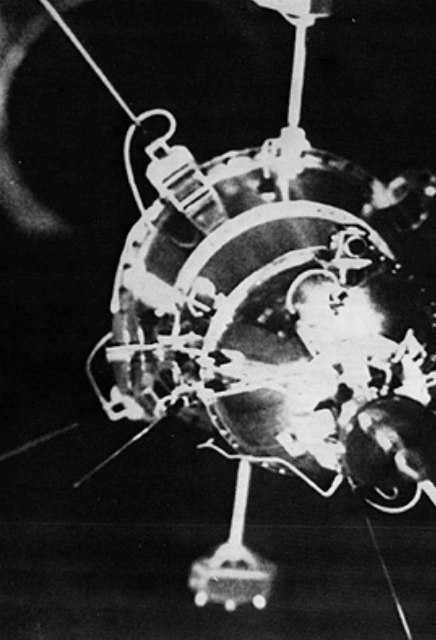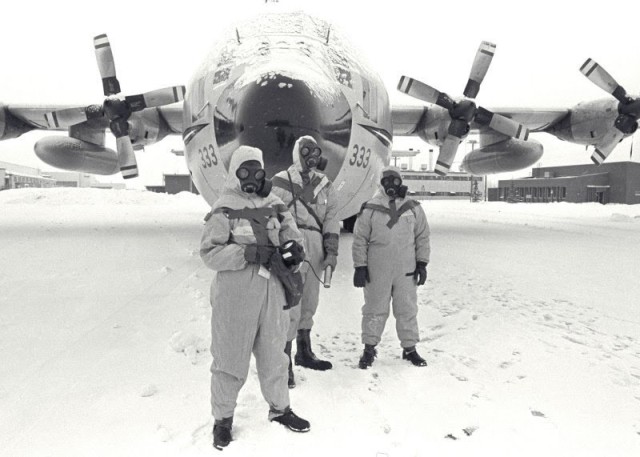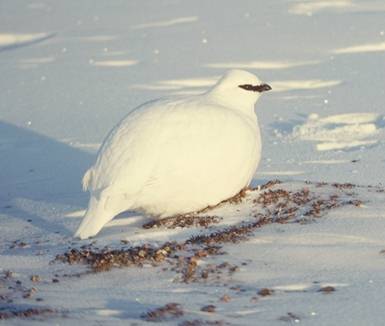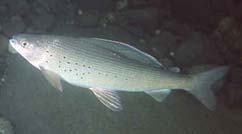Nuclear Code of Silence
Thirty-seven years ago, the Russian nuclear powered satellite Cosmos 954 returned to Earth during its 2060th revolution. Its debris crashed on the Canadian Far North close to the Arctic. It was the 24th of January 1978, 11h53 Universal Time, 5h53 at Yellowknife on the banks of Great Slave Lake, Northwest Territories Canada.
The decade 1970-1980 is marked by the worldwide launch of nuclear-based electricity. It is the height of the Atoms for Peace campaign launched in the 1950s to erase the horrors of the atomic bombs dropped on Japan. Nuclear for all is on the way.
Therefore, when Cosmos 954 started to go off course in November 1977 the nuclear club fell silent. From Moscow to Washington including Tokyo, Bonn, Paris, London, Canberra and Ottawa, mum’s the word. According to different sources Cosmos 954 contained 30.5 to 60kg of Russian 90% enriched Uranium-235 homologous with American Uranium-235 which, on August 6, 1945 struck and irradiated Hiroshima.
Eight days before the Cosmos 954 final reentry, a handful of Russian, American and Allies insiders knew that it would crash on the North American continent. Miami, Detroit, Chicago, the Great lakes were all sworn to secrecy. Right up until the end, up until day break on January 24, 257 million inhabitants were left in the dark about the explosive information.
Thirty-seven years after, there has been no long-term follow-up on the consequences of this nuclear accident. In the Northwest Territories, the environmental monitoring of the lakes and rivers deals with heavy metals, Persistent Organic Pollutants and indeed radionuclides but, in the administration’s own words: “radionuclides have received the least attention.” “There is a general lack of long-term, comprehensive monitoring of fish.” “Only sporadic information exists.” “Studies specifically designed to measure radionuclides in freshwater aquatic environments were not identified.” “Although the potential for human health impacts from radionuclide contamination of fish in the Northwest Territories exists, only limited data has been gathered on radionuclide levels in fish.”
These data deficiencies have not stopped the Indian and Northern Affairs Canada from declaring that traditional food sources are edible: “you can still enjoy them without worrying about health problems related to radiation.”
Cosmos 954 downfalls
1 – The fall
January 24 1978, at 11:53 Universal Time, a jewel of spatial technology penetrated into Canadian air space. Within 70 seconds, the Cosmos 954 on fire disintegrated in the sky over a straight course of 1000km and deposited on Canadian soil scrap metal, tiny pieces and radioactive particles. The “intrusion” as it was called by Canadian diplomatic circles of a Soviet nuclear powered satellite in an Arctic region qualified, for the event, “virtually uninhabited” was covered up by an international political consensus and by later terrestrial incidents such as Three Mile Island (1979), Chernobyl and Fukushima.
Normally, at the end of its working life the nuclear reactor of a Cosmos satellite is ejected from low orbits (+/- 200km) towards a cemetery orbit at an altitude of around 1000km; a type of space junkyard which allows for a total decay of short-life isotopes or medium-life isotopes such as, Iodine-131 Strontium-90, Cesium-137 before falling back to earth 500 to 600 years later. No official figures were given on the quantity of 90% enriched Uranium-235 on board Cosmos 954. The USSR always avoided clear replies. The minimal quantity was 31.5kg; the majority of the references mention 50kg. The half-life of Uranium-235 is 713 million years.
2 – Chronology
1977
– September 18 :
Launch of Cosmos 954 by the USSR from Kazakhstan.
– November :
US intelligence services identified management problems of the satellite.
– December 1 :
In the United States, the Under-Secretary of State for Defence is notified.
– December 19 :
Creation of an ad hoc committee on the space debris under the direction of the NSC (National Security Council)
1978
– January 6:
The NEST (Nuclear Emergency Search Team) tells its confidential interlocutors that the Cosmos 954 is falling and will crash on land or at sea in an unknown place on January 23 or 24.
– January 12-19 :
The United States approach the USSR through diplomatic channels and request accurate information on the in distress Cosmos 954.
The laconic reply from the USSR: the satellite is powered by Uranium-235. There is no risk of criticality or of explosion. The installation design will allow for the combustion and destruction in the dense layers of the atmosphere. There is a risk that parts or fragments will fall on the Earth’s surface causing local contamination without serious consequences which would require “the implementation of standard remediation measures”.
– January 18 :
NATO countries are informed as well as Australia, New Zealand, Japan and Canada. A recommendation to be discreet accompanies the information note. US Emergency Management Specialists consider it to be unnecessary to warn the population given the uncertainties on the location of the crash. This is a world first. All informed countries observed the code of silence. Before the crash of Cosmos 954, no Head of State or Prime Minister had to mention the disaster scenario of an atomic explosion, which was still feared despite the Soviet Union’s reassurances. Nor did they need to address the isolation or removal measures in case Cosmos 954 crashed on a metropolis or a densely populated valley.
A White House advisor explained later that the priority was to avoid a remake of the War of the Worlds. In 1938 CBS Radio broadcasted an adapted version of H.G. Wells’ science fiction novel for Halloween. The editing by Orson Welles, striking realistic, is said to have triggered a collective panic.
– January 24
At 6:53 (Eastern Standard Time in Ottawa), a red hot and silent object suddenly appeared in the Southwest of Canada and disappeared in the Northeast. 22 minutes later, Pierre Elliott Trudeau the Canadian Prime Minister is informed by Jimmy Carter the United States President that the Soviet satellite has crashed in Canada’s Far North of the country.
Following a misleadingly reassuring model, it was quickly declared that only an area of 124,000 km2 cut with a scalpel was likely to have received the debris from the radioactive satellite. Looked at on a map, the area looks like a revolver. To the west the area includes Great Slave Lake, 27,200 km2, frozen from September to April, which flows into the Mackenzie River’s basin, which in turn flows into the Beaufort Sea and the Arctic Ocean. To the east the Wildlife Sanctuary of Thelon River which flows into Baker Lake and into Hudson Bay.
3- Operation Morning Light
By the evening of January 22, radioactivity detectors, decontamination tools, containers, helicopters, trucks, computer equipment, and special equipment were embarked on cargo aircrafts at 3 military bases in Washington DC, California and Nevada. The force is ready to intervene where the Cosmos 954 will fall. For several days it has been assessed that the point of impact would be on the North American continent. 247 million inhabitants are still unaware of the danger. Very quickly during the morning of the 24th, Canada and the United States have reached an agreement to carry out joint rescue and emergency operations. Operation Morning Light – a code name which permitted all the laboratories and American services on alert to communicate in secret for a couple of weeks on the subject of Cosmos 954 – is now underway and briskly exposed to the public and to the international press. At the same time a U2 from the US Air Force was analysing the air at high altitudes above the Canadian Arctic trying to detect plumes of U-235 and fission products. The negative results indicate that most of the artificial radioactivity from the satellite wreck was actually falling more or less quickly on Earth.
Between January 24 and March 25, 608 flyovers of the area thought to be contaminated tracked down from an average altitude of 300 m physical traces and radioactive traces of the Russian satellite. One hour of flight time by 4 Canadian C130’s produced electronic data decipherable within 4 hours. The interpretation of the raw data was sloppy. Very strong signals of radioactive aggregates were detected while the teams landing onsite from helicopters on the tundra and on frozen lakes were unable to relocate them. The search for reactor core which was thought to have dug into the permafrost a crater of about 1 m in depth was carried out in vain. Gamma-ray spectrometers and computers could not withstand the extreme variations in temperature. Ground teams designated to find and pack the waste were also having a very tough time, immersed in the Arctic winter and in the atomic fear.
The preliminary report published in September 1978 was validated by the American Head of Operation Morning Light. It presented the hypothesis that the reactor core had vaporised into fine particles and that 75 % of the radioactivity was concentrated on the bottom and on the banks of the lake.
The scientific journal Health Physics noted in August 1984, in an article focused on the health impacts of the disaster, that at least a quarter of the reactor – ie: 7 to 8 kg – had fallen in the form of fine particles less than 1mm in diameter. These micro particles fell like an invisible slow fog on the Northwest Territories and on the barren Arctic and sub-Arctic land. In April and May, following the thawing of the rivers and lakes and the melting of the snow on the tundra, they were remobilised, sedimented and accumulated in unidentified areas.
4- Information to the public
5- Protocol agreement
On April, 2nd 1981 Canada and the Soviet Union signed in Moscow a protocol of agreement valuing at 3 million Canadian dollars the damages be awarded to Canada for all of the consequences caused by the disintegration of the Cosmos 954. To substantiate its claim, Canada points out to the USSR that they had not replied to the questions sent on January 24, 1978 resent on January 27, February 8 and April 13, concerning the nuclear reactor and the debris discovered in the Northwest Territories, in Alberta and in Saskatchewan. Furthermore, Canada stressed that all the debris except 2 were radioactive, that some were deadly, that inscriptions in Cyrillic alphabet were found on one of the samples, that the clean-up operations carried out in 2 phases (January 24 – April 20) ( April 21 – October 15), which aimed at circumscribing and reducing the actual damage, at reducing the risk of future damage and at remediating in the best possible way all the areas impacted by the intrusion of the satellite, returning them as close as possible to their original state as if the Cosmos 954 intrusion and waste downfall had not taken place. This agreement was based on the international responsibility for damage caused by spatial objects Convention (1972).
6- New downfalls 29 years after
In 2007, former employees of the weather station at Fort Reliance asked the Canadian government via legal channels questions on the transit of Cosmos 954 waste within their workplace and on the possible risks that they or people who lived for over 2 years within the areas contaminated by the U-235 could have been exposed to. The Ministry of Defence answered that “the debris had indeed transited via Fort Reliance that they had been stored in adequate containers to avoid any external contamination eg: adequately lead shielded boxes.” The containers were then flown to Yellowknife and then to Edmonton (Alberta) for temporary storage in a special cask provided by the Ministry of Defence while waiting to be sent under escort towards Winnipeg then to Pinawa (Manitoba) for storage.
In its response the Ministry of Natural Resources underlined that at the time of the Cosmos 954 crash, Canada did not have a specific political policy for this type of unique situation. “A federal Plan in case of nuclear emergency” was put in place in 1984. This plan is managed by Health Canada.
Health Canada replied that they had not participated in any of the inspections carried out at Fort Reliance and recycled the same arguments as 1978: “If a particle was accidentally ingested, it would transit intact through the digestive tract.” “The estimated doses exiting the large intestine would range from 40 to 140 mSv.” “These doses are typical of specific diagnostic radiology procedures.” “No harmful effect on health should be expected at these levels.”
Health Canada does not consider that inhabitants could have ingested radioactive particles several times and expresses the opinion that from 1980, no risk could still exist for anyone touching, manipulating, inhaling or ingesting debris!
7- Where is the U-235 ?
A – The Thelon Sanctuary
It was in the heart of this Sanctuary that the greatest amount of larger debris from the Cosmos 954 was found between the end of January and April 1978. The Thelon Wildlife Sanctuary was created in 1927 to protect muskox and caribou from extermination by hunter trappers. As early as 1930, the Canadian government had banned all mining activities from the interior of the park thereby also protecting it from all discarded waste, except waste coming from the sky.
The fauna in the Thelon Sanctuary was contaminated by the fallout of Cosmos 954. Caribou feed on terrestrial and arboreal lichens and fungi, muskox feed on grass on the tundra and ptarmigan feed on berries, on invertebrates and on buds. All the fauna including a dozen fish species in the rivers and lakes were contaminated. Nobody knows the level of radioactivity introduced into the food chain of herbivores, piscivores or omnivores such as wolves and bears and on food chain of Inuits and Indians hunters-gatherers on all the contaminated areas.
B- Great Slave Lake
It is the second largest ecosystem directly impacted by the radioactive pollution from the satellite. Etymologically, the name is derived from Slavery, one of the First Nations Tribes from the Mackenzie Basin. It is the 9th largest lake in the world. Recreational and commercial fishing is very prominent today between May and September. Islands, marches, rivers and shores are used as breeding grounds by numerous species and as a resting place for migrating birds that follow the Mackenzie valley in spring to go and breed on the shores of the Arctic Ocean.
In his book Operation Morning Light – Terror in the Sky, the True Story of Cosmos 954 – which was published late 1978, Leo Heaps wrote in his last chapter on the subject of contamination: “who will have the courage to say that the fish in Great Slave Lake are radioactive?”
Considering the international feedback of nuclear accidents since 1985, Robin des Bois considers that the Canadian government has an obligation to instigate a full radioactive survey including the sediments, the benthic flora and fauna and fish of the Great Slave Lake, taking into account the long-lived radionuclides.
On the same subject:
“Space waste”. Robin des Bois (pdf 60p.)
“Polar Star” n#2. 2750 contaminated sites in Arctic
Writing :
Jacky Bonnemains
Research and illustrations:
Miriam Potter, Jean-Pierre Edin, Christine Bossard et Charlotte Nithart
Maps :
Christine Bossard
Translation :
Miriam Potter et Jacky Bonnemains
Sources
Aftergood, Steven. “Background on Space Nuclear Power.” Science & Global Security, Vol. 1 pp. 93-107, 1989.
AMAP, 1997. “Arctic Pollution Issues: A State of the Arctic Environment Report.” Arctic Monitoring and Assessment Programme (AMAP), Oslo, Norway. Xii pp.188.,1997.
Benkö Marietta et al., Space Law in the United Nations Boston: Martinus Najhoff, 1985.
Community Population Estimates by Ethnicity Northwest Territories, July 1, 2014 and July 1, 2001.
Department of External Affairs – Ministere des Affaires exterieures, Canada. “Canada: Claim against the Union of Soviet Socialist Republics for Damage Caused by Soviet Cosmos 954”, No. FLA 268, Ottawa, K1A OG2. March 15, 1979. Note of February 28, 1978,No. FLO-0497. Note of March 3, 1978, No. FLO-0532 and Annex. Note of April 13, 1978, No. FLO-0840. “Unofficial Translation of the Note of May 31, 1978, from the Embassy of the Union of Soviet Socialist Republics at Ottawa”. Note of December 18, 1978. No. FLO-2884 and Annex.
Ducrocq, Albert. “La chute de Cosmos 954 – L’aventure spatiale vient de connaître sa première alerte nucléaire… ” Sciences & Avenir, No. 373, March, 1978
<http://atomicsarchives.chez.com/chute_cosmos954.html.>
Editorial “Nation: Cosmos 954: An Ugly Death” Time Magazine, February 6, 1978.
Editorial “Satellite Crisis Stirs Controversy” Reading Eagle Sunday 29, 1978, p.6.
Elliot, S.E.M., et al., from Western Region Department of Fisheries and Oceans Winnipeg, Manitoba. “Cesium -137, Radium -226, Potassium-40 and Selected Stable Elements in Fish Populations from Great Slave Lake (NW.T.), Louis Lake (Saskatchewan), Lake Winnipeg (Manitoba), and Experimental Lakes Area (Northwestern Ontario)” Canadian Data Report of Fisheries & Aquatic Sciences No. 293, October, 1981.
Enrique, a456 “Death, Caribou, Cosmic Debris, and Parabolas on the Thelon River” Aggregat456.com Tuesday, May 18, 2010
<http://www.aggregat456.com/2010/05/death-caribou-cosmic-debris-and.html.>
Frazier, N., Douglas., Ed. Journal of Space Law – A journal devoted to the legal problems arising out of man’s activities in outer space. L.Q.C. Lamar Society of international Law of the University of the Mississippi School of Law Vol. 6, No. 2, 1978, p.106.
“Great Slave Lake”. Encyclopædia Britannica. Encyclopædia Britannica Online. Encyclopædia Britannica Inc., 2015. <http://www.britannica.com/EBchecked/topic/243729/Great-Slave-Lake>.
Hagen, Regina. “Past Missions: a Chronology” Flybynews August 11, 1998.
Hamelin, Louis-Edmond, “La Population des Territoires-du-nord-ouest au cours des années 1960 et 1970.” Université Laval, Québec.
Health Canada, “The Cosmos 954 Accident” Modified June 24, 2008.
<http://www.hc-sc.gc.ca/hc-ps/ed-ud/fedplan/cosmos_954-eng.php.>
Heaps, Leo. Operation Morning Light: Terror In Our Skies: The True Story of Cosmos 954. New York: Paddington Press, 1978.
Hore-Lacy, Ian. Nuclear Reactors for Space, World Nuclear Association December 6, 2009.
Indian and Northern Affairs Canada, Northwest Territories Contaminants Fact Sheets. “Radionuclides”
IRSN – Institut de Radioprotection et de Sûreté Nucléaire. « Note d’information : L’uranium et les risques associés. » July / Juillet, 24, 2008.
“La chute de Cosmos 954” Info Nucléaire, depuis Septembre 1998, Site d’information sur le nucléaire.
<http://www.dissident-media.org/infonucleaire/chute_cosmos.html.>
Lokan, Dr., K., H., Address for the Australian Radiation Laboratory “Cosmos 954 – A Case Study”.
Moshenko, R. W., Gillman, D.V. from Western Region Department of Fisheries and Oceans
Winnipeg, Manitoba. “Creel Census and Biological Data from the Lake Trout Sport Fishery on Great Bear and Great Slave Lakes, Northwest Territories, 1979”. Canadian Data Report of Fisheries & Aquatic Sciences No. 307, April, 1982.
Nazarenko, A.I., et al., “Spacecraft with a Nuclear Power system and Problems of Space Debris”. Proceedings of the Fourth European Conference on space Debris, Darmstadt, Germany, 18-20 April 2005.
Petition No. 199: Préoccupation au sujet de l’environnement et de la santé à la station météorologique de Fort Reliance, April 2007.
Richelson, T. Jeffrey. Defusing Armageddon: Inside Nest, America’s Secret Nuclear Bomb Squad. New York: WW. Norton & Company, 2009.
Robin des Bois. “Space Waste”, June 2011.
<https://robindesbois.org/english/Space-Waste.pdf.>
SENES Consultants Limited for Aboriginal Affairs and Northern Development Canada, NWT Environmental Audit Status of the Environment Report. December, 2005.
Taylor, Mitchell from Wildlife Research Section. “Thelon Wildlife Sanctuary: Final Report” Nunavut, Report No. 10, 2006.
Tracy B.L., Prantl, F.A., Quinn, Q.M. “Health Impact of Radioactive Debris from the Satellite Cosmos 954” Health Physics Society, 47(2):225-33 August, 1984.
United Nations General Assembly, Committee on the Peaceful uses of Outer Space. “Note verbale dated 19 December 1978 from the Permanent Representative of Canada to the United Nations addresses to the Secretary- General. A/AC.105/236 22 December, 1978.
United States Department of Energy, Nevada Operations Office Las Vegas, Nevada. “Operation Morning Light Northwest Territories, Canada –1978: A Non-Technical Summary of U.S. Participation” Authorized for Publication by Gates E. Mahlon, Senior U.S. Government Representative, Operation Morning Light, September 1978.
Wallace, Ron. “Why Canada Needs a Robust Arctic Air Rescue Capacity: A policy Update Paper”. Canadian Defence & Foreign Affairs Institute, March 2009.
Weiss, W., Gus. “The Life and Death of Cosmos 954”. CIA historical Review Program Vol. 22, Spring, 1978.
 Imprimer cet article
Imprimer cet article




























